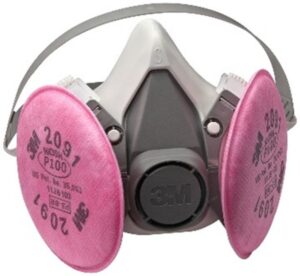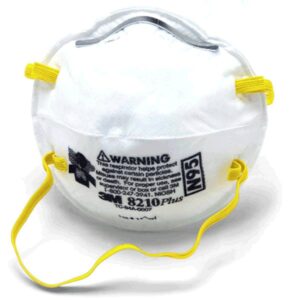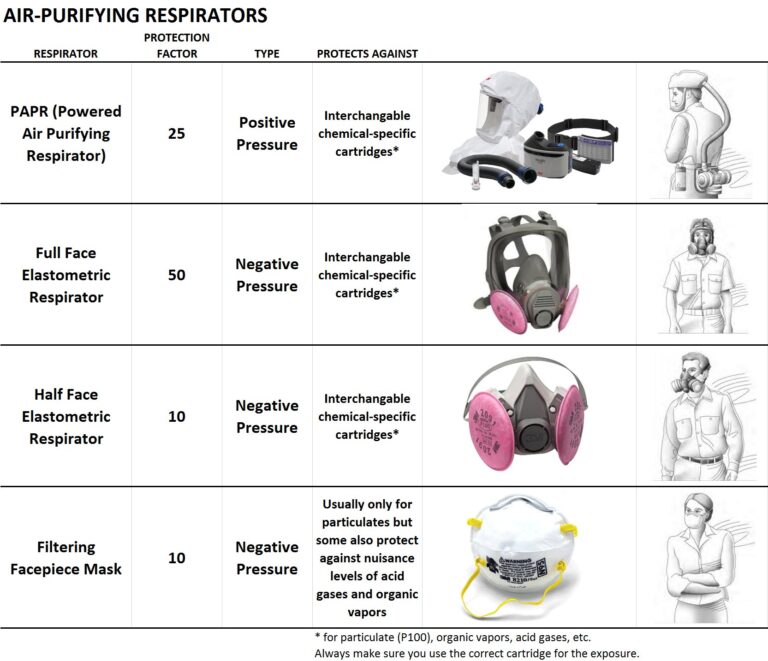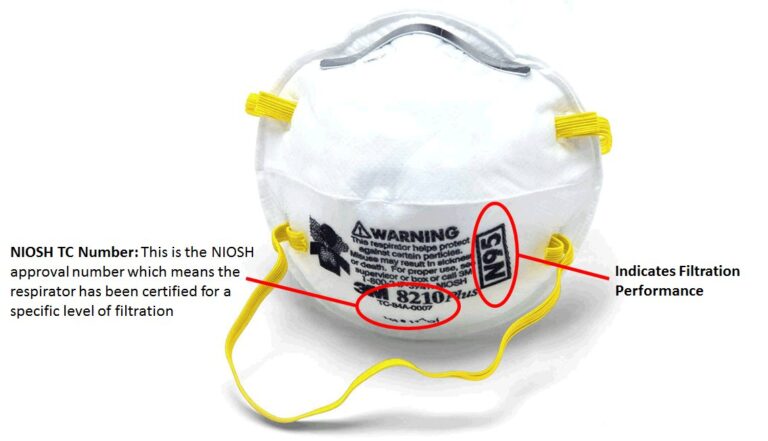Health & Safety:
PPE & RESPIRATORS
Updated 01/06/2023
Personal Protective Equipment:
It is very important to protect yourself while working in the glass studio. Remember to protect your:
- Eyes (Safety Glasses)
- Face (Face Shield)
- Lungs (Respirator)
- Hands (gloves)
- Skin (appropriate clothing)
- Feet (wear closed toe shoes)
Safety Glasses:
While respiratory protection, hearing protection and heat protection are addressed elsewhere in this section, I want to make a few comments about EYE PROTECTION:
- Always wear SAFETY GLASSES when working in the glass studio.
- The current standard for safety eyewear is published by the American National Standards Institute (ANSI) is called the Z87. 1-2010 standard.
- If you wear prescription glasses, you can wear safety glasses over them or you can order safety glasses in your prescription.
- Most manufacturers make safety glasses with “cheaters” which have magnification.
Respirators:
Respirators are devices that selectively purify breathing air. They are essential when working around many chemicals and dusts. Always wear the right respirator for the exposure! Different respirators protect against different exposures. Respirators must be worn correctly and there must not be anything interfere with the seal to the face (beards!). Always read and understand the label before using a respirator so that you understand how to wear it correctly and understand its limitations.
Wearing a respirator creates breathing resistance. Talk to your physician before wearing a respirator if:
- You have Coronary Heart Disease
- Respiratory Issues (Emphysema, Asthma)
- Pregnant
Respirators come in a variety of styles and uses:
- Air Supplied: These are the type of respirator used for unknown atmospheres or atmospheres that are deficient in oxygen. They either have a tank (SCBA) or an airline running to a pump. These types of respirators are almost never used in glass studios and will not be discussed here.
- Air Purifying: These types of respirators have some sort of filter. These can be positive pressure (a pump moves the air) or negative pressure (your lungs move the air).



When purchasing respirators always make sure it is NIOSH approved. NIOSH is the National Institute for Occupational Safety and Health and is a division of the CDC (Centers for Disease Control). There will be a TC (Testing and Certification) number on the respirator. There are many counterfeit respirators on the market these days so always buy from a reputable seller. You can also check the NIOSH database to verify the TC number.

Filtration Performance
- N95 – Not resistant to oil, 95% efficient for particles ≥ 0.3 µm (microns)
- R95 – Resistant to oil for a limited time, 95% efficient for particles ≥ 0.3 µm (microns)
- P95 – Oil proof, 95% efficient for particles ≥ 0.3 µm (microns)
- P100 – Oil proof, 99.7% efficient for particles > 0.3 µm (microns)
95% efficient (N/R/P95) is adequate for most dust exposures in a glass art studio. Upgrade to a 100% efficient (P100) cartridge for exposures to very toxic materials such as RCF (Refractory Ceramic Fibers), asbestos or silica. If a filter is N, R or P is not a big issue. Buy what is available. There is also a KN95 designation which is the Chinese equivalent to N95.
Protection Factors
- Indicator of the effectiveness of a particular type of respirator
- The higher the Protection Factor, the better the respirator is at protecting the wearer
- Assigned by NIOSH
- Exposure Limit X Protection Factor = Level of Protection
- Example: 5 mg/m3 X 10 = Respirator is effective for exposures up to 50 mg/m3
How to Use a Respirator
- Respirators are available in a variety of sizes – make sure you buy the right size for your face.
- The respirator must be properly positioned over your nose and mouth at all times.
- The top strap or head harness assembly is positioned high on the back of the head.
- The lower strap is worn at the back of the neck below the ears.
- Do not buy one strap respirators! They do not fit well.
- The straps are snug enough to keep the respirator from moving but not overly tight.
- Nothing (beards, head coverings, etc.) passes between the skin of the face and the respirator’s sealing edge.
Respirator must fit tightly to your face to work properly. Always check the fit. This is easiest for an elastometric respirator:
- Negative pressure – put your palm over the filter and breathe in – the respirator should slightly collapse on your face and you should not feel a leak .
- Positive pressure – put your palm over the exhalation valve and breathe out – you should not feel a leak.
- Do this every time you put on a respirator!
- Filtering facepiece masks are difficult to fit test so make sure they are tight and when breathing in and out you do not feel excessive airflow around the mask, especially the nose.
Changing Respirators/Cartridges:
Store the respirator and cartridges in a plastic bag to protect it when not in use. The fastest way to ruin a respirator is to let it get dirty or expose the cartridges unnecessarily. Cartridges should be changed regularly. Replace the dust mask or change the filters when you notice:
- Increased breathing resistance (dust cartridges)
- Physical damage to any part of the facepiece or filters
- The inside of the dust mask becomes unsanitary
- Time use limitations for the specific respirator require replacement
- If smell, taste or irritation from the contaminant(s) is detected
- Follow the recommendations of the respirator manufacturer
What a Respirator Can Do:
Filtering Facepiece:
- Good for Dust/Fume/Mist exposures
- Good for nuisance dust, paint (latex) mist
- Does NOT work for chemical vapors (acetone, ammonia, etc.). However, there are some filtering facepieces that offer nuisance exposure control for some chemicals such as organics and acid gas.
- Does NOT work for gases (carbon monoxide, sulfur dioxide, etc.)
Elastometric – Particulate Cartridge
- Not for chemical exposures, however, there are some particulate cartridges that offer nuisance exposure control for some chemicals such as organics and acid gas.
- N95 cartridge is appropriate for non-toxic dust.
- P100 cartridge is appropriate for toxic dusts like RCF, silica dust, Lead.
Elastometric – Chemical Cartridge
- Variety of chemical-specific cartridges are available
- Organic vapor, Acid Gas are most common
- Always insure you select the correct filter for the exposure
What a Respirator Can NOT Do:
- Unless you are wearing an air-supplied respirator, it cannot provide a breathing atmosphere when there is a lack of oxygen. Air-purifying respirators are designed to purify the air, not supply oxygen.
- An air-purifying respirator cannot protect against exposures for which it was not intended. Always make sure you have the right respirator for the exposure.
Wearing Masks During the COVID-19 Pandemic:
Many municipal governments are mandating the wearing of masks to help prevent the spread of the COVID-19 virus. Because of the unavailability of recognized effective respiratory protection, many companies and individuals are making masks. None are as effective as a N95, but some are better than others. People are being required to wear masks without the necessary training and guidance. Click on the button below for a document which provides advice and guidance on which masks work best (and which don’t), how to wear a mask and how to take care of a mask.
